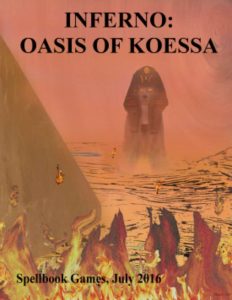
By Paul Elkmann/Geoffrey O. Dale
Spellbook Games
1e/Portal to Adventure
Level 10+
“Oasis of Koessa is an adventure set on the Seventh Circle of Hell, the Desert of Fire, can be used as a projection of Hell into the Material Plane, or it can be used as an enchanted location in any remote hot desert. It can represent any of nine Oases found in the Desert of Fire. The Oasis is a dangerous and challenging location suitable for challenging higher-level Adventurers. The non-linear location contains eight significant structures which can be explored in any order, each with different challenges and opportunities. The centerpieces are the two large Pyramids and the dungeon inside a Sphinx statue.”
This 69 page adventure describes an oasis on the seventh circle of hell. It’s packed full of mummies and their minions. Like the blurb says, three dungeons, and extensive at that. It’s also a pretty textbook example of the mechanics of writing getting in the way the adventure. Wall of text. Detailed room descriptions. Hordes of creatures stuffed in rooms. It burdens my soul just thinking about it.
I am NOT in the mood for this thing this morning.
Let’s talk room descriptions. What’s the goal? As always: helping the DM at the table. More specifically, picking out the important stuff in the room and describing it in a way that the flavor is communicated by the text from the designer to the DM’s head … who can then attempt to send it on to the players. How does one accomplish this? There are several possible paths. One path which is NOT useful is the one that FAR too many adventures fall in to: describing the room in excruciating detail.
We the room it titled “Kitchen” then the DM can fill in the details; we know what a kitchen looks like. Maybe the room is titled “Clean Kitchen” or “Greasy Kitchen” or something else. The designer is leveraging the DM in communicating the vibe. They are then free to add to description things like “The master key is inside a loose chimney stone.” or “The grease makes the floor slippery and the rusty knife collection is stored on the low, open shelves …” The descriptions focus both on the evocative, to communicate the vibe well to the DM, as well as the mechanics of things actually useful to the adventurers.
Revisiting our kitchen example, lets follow where the contra example takes us. If we exhaustive list he contexts of the kitchen then what does that get us? Seven bowls, Six spoons (one bent), a 10’ by 11’ work surface with a knife cut in the upper right hand corner 1 foot from the left edge running parallel to the lower edge. Unless those elements are relevant to the adventure then they do nothing but clog up the text and distract the DM from from the evocative nature of the room and the mechanics of the party interaction with it. The seven bowls could be a clue … in which case it IS relevant to the adventure, if the party needs to know/would be helpful to know there are seven people using bowls.
Besides this exhaustive listing of room contents there is also the “where does the door go” commentary. “The archway to the west goes room 14, the kitchen.” Well, yes, that is what the map indicates ,,, s why does the text tell us that also?
This, along with poor formatting choices, can lead to wall of text issues. All of the text just runs together, visually, and your eyes glaze over.
Here’s an example of the text from room three of the funerary temple. This is one paragraph of six, with the entire thing taking up over a page of text.
“The room has arches to the Embalming Room, the Wrapping Room, and to the Entry Curtain. An 8 FT by 5 FT mahogany table on the western side of the room supports a large bright blue wooden sarcophagus which is sealed with a line of lead solder (requires a knife/scraper). A 50 inch bronze gong hangs in a black wood frame to the left of the table with a hook for the 30 inch clapper; sounding the gong has no immediate impact. Two 7 FT by 4 FT black granite altars are along the east wall, separated by 10 FT. An 8 FT diameter silver spider with 8000 GP diamond eyes is mounted on the north wall in front of one altar; an 8 FT di- ameter gold ram’s head with 12,500 GP ruby eyes and 14,000 GP ivory horns is mounted on the south wall. A 12 FT diameter circular brown-and-orange carpet is between the altars. Lit golden lanterns are to the north and south walls, spaced 5 FT apart.”
Are the dimensions of the table relevant? Is the spacing of the lanterns relevant? The size of the gong? I would assert that most of the text description is irrelevant, and that which IS relevant is boring. “A silver spider with diamond eyes” barely makes the grade.
And remember, that’s one paragraph of six. The adventure engages in this over and over again. Everything is just beaten to death, and then to a pulp. Seldom have I cared less about what I’m reading. Useless detail without writing to inspire.
This is $4 on DriveThru. The preview is about six pages and the last few give you an idea of what to expect in terms of writing. It’s not actual rooms, but it is indicative. https://www.drivethrurpg.com/product/189270/Oasis-of-Koessa?affiliate_id=1892600
